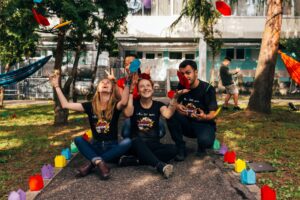- Understand the concepts of sets, including empty sets, subsets, and proper subsets, and use correct set notation
- Describe and perform set operations (union, intersection, complement, and difference) using proper set notation
- Create and interpret Venn diagrams to represent and analyze set relationships and operations
- Apply the concepts of sets, subsets, and cardinality properties to solve real-life problems
School Charity Event

Sets provide a structured way to group objects or individuals, which is particularly useful in organizing and understanding relationships within different categories. In practical scenarios like planning a school charity event, we use sets to clearly define group memberships.
You have been appointed as the event coordinator for the school charity event. For this event, we need to organize the [latex]36[/latex] students who are part of the Art Club, Science Club, and Drama Club.
- The Art Club (A) has a total of [latex]17[/latex] members.
- The Science Club (S) consists of [latex]15[/latex] members.
- The Drama Club (D) has [latex]22[/latex] members.
Some students are members of multiple clubs.
- [latex]3[/latex] students are members of both the Art Club and the Science Club.
- [latex]6[/latex] students are members of both the Art Club and the Drama Club.
- [latex]5[/latex] students are members of both the Science Club and the Drama Club.
- [latex]2[/latex] students are members of all three clubs.
To manage the event smoothly, we can assign each student a unique number, [latex]1-36[/latex], based on their club memberships. This numbering system ensures that every student is counted once, and it helps us see the intersections between clubs clearly for our records and event planning.
Student numbers are designated as follows:
- [latex]1[/latex] to [latex]6[/latex]: Art Club only (This is [latex]17[/latex] total Art Club members minus the [latex]3[/latex] in both Art and Science, the [latex]6[/latex] in both Art and Drama, and the [latex]2[/latex] in all three clubs, resulting in [latex]6[/latex] members who are only in the Art Club)
- [latex]7[/latex] to [latex]11[/latex]: Science Club only (This is [latex]15[/latex] total Science Club members minus the [latex]3[/latex] in both Art and Science, the [latex]5[/latex] in both Science and Drama, and not including the [latex]2[/latex] in all three clubs, resulting in [latex]5[/latex] members who are only in the Science Club)
- [latex]12[/latex] to [latex]20[/latex]: Drama Club only (This is [latex]22[/latex] total Drama Club members minus the [latex]6[/latex] in both Art and Drama, the [latex]5[/latex] in both Science and Drama, and not including the [latex]2[/latex] in all three clubs, resulting in [latex]9[/latex] members who are only in the Drama Club)
- [latex]21[/latex] to [latex]23[/latex]: Art and Science Clubs
- [latex]24[/latex] to [latex]29[/latex]: Art and Drama Clubs
- [latex]30[/latex] to [latex]34[/latex]: Science and Drama Clubs
- [latex]35[/latex] and [latex]36[/latex]: All three clubs.
To start organizing the event, you need to create sets for each club based on their membership.
Having examined the individual club memberships, let’s delve into their intersections to uncover how the memberships interact.